Caputia pyramidata
Caputia pyramidata (DC.) B.Nord. & Pelser (= Senecio pyramidatus DC.)
Family: Asteraceae
Common names: tall caputia (Eng.); groot-tontelbos (Afr.)
Introduction
Caputia pyramidata is a drought-tolerant succulent-leaved shrub, endemic to the Albany Thicket vegetation in the Eastern Cape. It has showy, ascending leaves and a beautiful conical to pyramid-shaped inflorescence with striking yellow daisy flowers, ideal for the waterwise garden.
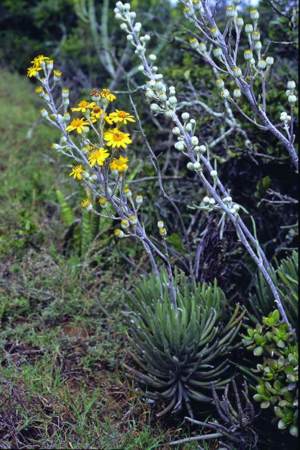
Description
Description
Plants ascending, sparingly-branched succulent shrubs, to 1.8 m tall (with inflorescence). Roots are fibrous and not succulent. Stems are branched mainly from the base, at first very hairy, becoming hairless (glabrous) and grey-green with age, up to 1 m long.
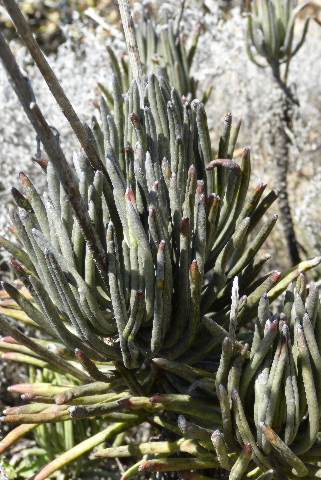
The leaves are ascending, cylindrical, about 80-150 mm long and about 5-10 mm in diameter, densely crowded at the ends of the branches, and alternately arranged, grey-green, often with darker markings. During the dry season, leaves are distinctly channelled on the lower side and they bend inwards and their tips become reddish. The lower leaves eventually become deciduous which leaves the lower portions of the stems bear, exposing the dark bark and leaf scars. Leaf ends taper to acute points.
The inflorescence is conspicuous, ascending and elongated (almost as long as the stems), often conical or shaped like a pyramid, bearing large yellow daisy flowers. The daisy flowers (involucre) are shaped like a cup or hemispherical, covered with white hairs on the outside with both disc (inner) and conspicuous ray (outer) florets. The elongated seeds are attached to numerous white bristles.
Conservation Status
Status
Although only known from a few sites in the Albany Thicket, it is still fairly common in Gamtoos Thicket and Great Fish River Noorsveld in the Eastern Cape (Mucina & Rutherford 2006) and consequently has been given a status of Least Concern (LC) in the Red List of South African Plants (Raimondo et al . 2009). This species is well established in cultivation (ex situ conservation) and is grown by succulent plant growers (Rowley 1994).
Distribution and habitat
Distribution description
Caputia pyramidata is only known from the Eastern Cape between Hankey, Grahamstown and Peddie. It is related to Caputia tomentosa (= Senecio haworthii), the latter with dense silvery-white leaves and spreading stems confined to the Richtersvel and the Great and Little Karoo regions.
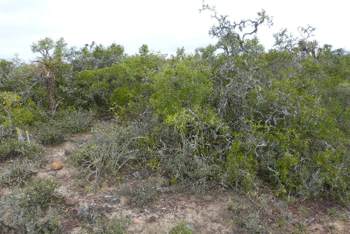
Our species is mainly associated with Albany Thicket vegetation (Mucina & Rutherford 2006). It grows unarmed but finds it protection among many thorny shrubs such as Carissa bispinosa, Azima tetracantha, Searsia longispina and Asparagus densiflorus. Although rain falls during summer and winter and ranges from 250-500mm per annum, there is a tendency toward winter dryness. The average annual daily maximum temperature is about 23°C and the average daily minimum about 12°C. Caputia pyramidata grows at an altitude of 100-600m, on soils derived from Enon Conglomerate as well as shale outcrops. The soil varies from sandy to loam and slightly acidic. The plants grow in full sun with the cylindrical silvery green leaves ascending orientating themselves to minimize their exposure to sunrays. Furthermore, plants are covered with dense felty silvery hairs which reflect rays from the sun - an adaptation to the dry sunny environment. Near Hankey the plants were growing in association with the following species: Aloe pluridens, Gasteria pulchra, Bulbine latifolia, Delosperma pruinosum, Crassula capitella subsp. thrysiflora, C. cultrata, C. perforata, C. perfoliata var. minor, C. tetragona subsp. tetragona, Cotyledon orbiculata, Euphorbia mamillaris, Albuca longibracteata, Asparagus densiflorus and Pelargonium zonale. Larger trees and shrubs in the habitat include Cussonia gamtoosensis, Portulacaria afra, Euclea undulata and Osteospermum moniliferum.
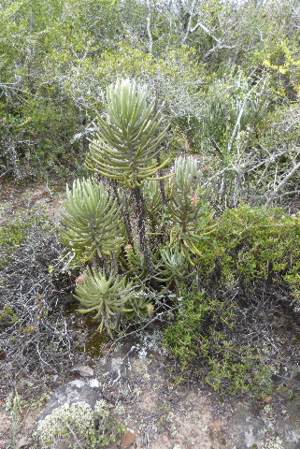
Derivation of name and historical aspects
History
Formerly part of the large genus Senecio, the new endemic genus Caputia was established by Nordenstam and Pelser in 2012 to accommodate five succulent species, mainly confined to dry habitats in the Northern, Western Cape and Eastern Cape and KwaZulu-Natal. The other four species are C. tomentosa, C. oribiensis, C. scaposus and C. medley-woodii, all drought tolerant succulent shrubs or shrublets with horticultural value.
The generic name Caputia was established by Bertil Nordenstam and Pieter Pelser in 2012. The authors describe this name as 'an illusion to their geographical origin' (Nordenstam & Pelser 2012). It is named after the old geographic region Caput bonae spei which was the Latin name formerly applied to the Cape of Good Hope. This plant was first named by the well-known Swiss botanist Augustin Pyramus de Candolle (1778-1841) in 1838 in his Prodromus as Senecio pyramidatus.
Ecology
Ecology
Caputia pyramidata flowers during winter and spring (July to November), it is pollinated by insects and the seeds, which are borne on the elongated inflorescence, are dispersed by wind. Seeds ripen during spring and summer and coincide with the summer growing season. The succulent nature of the plants makes it tolerant of long dry conditions which are regularly experienced in its native habitat.
Uses
Use
Apart from its horticultural use, the plants are not used medicinally.
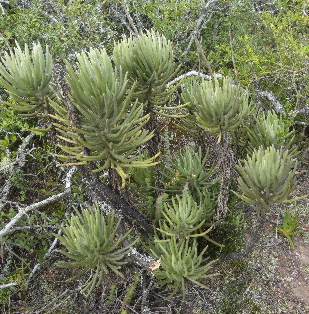
Growing Caputia pyramidata
Grow
Caputia pyramidata is a slow-growing attractive shrub with horticultural appeal and is best suited for Thicket Gardens (Van Jaarsveld 2010). It is best grown in full sun as a focal point. Its ornamental value is characterised by its decorative ascending growth of crowded silvery grey-green leaves crowded at the branch ends with its striking tall yellow flowers. Although it prefers full sun, when grown in slightly shady conditions the leaves tend to be longer and greener. Their soil should be well-drained and they thrive in rockeries on sunny slopes.
Caputia pyramidata does well in cultivation, especially Mediterranean type gardens in Europe and California where frost is not severe. It also makes a wonderful container subject. It is best grown out of doors but can also be planted in conservatories in cold climates. Plants should reach flowering size in about three years.
Caputia pyramidata are easily propagated from stem cuttings. It can be done throughout the year but is best done during the spring or summer when it should root rapidly. Grow in sand or gravel and place in a warm, sunny position. Rooting should take place within four weeks. It is best to allow the stem cutting to form a heel by placing it on a dry window sill for a week or three. Cuttings are best rooted in a small container in a well-drained medium. Once rooted, they can be planted out in containers and kept until ready for planting in a sunny well-drained spot in the garden. Feed plants with an organic fertiliser (compost or any other liquid fertiliser). Although Caputia pyramidata can be watered at any time of the year, watering should be reduced during winter.
References
- De Candolle, A.P. 1838. Prodromus systematis naturalis regni vegetabilis , Vol. 6. Treuttel et Wurtz, Paris.
- Mucina, L. & Rutherford, M.C. (eds) 2006. The vegetation of South Africa, Lesotho and Swaziland. Strelitzia 19. South African National Biodiversity Institute, Pretoria.
- Nordenstam, B.E. & Pelser, P.B. 2012. Caputia, a new genus to accommodate four succulent South African Senecioneae (Compositae) species. Compositae Newsletter 50: 56-69.
- Raimondo, D., Von Staden, L., Foden, W., Victor, J.E., Helme, N.A., Turner, R. C., Kamundi, D.A. & Manyama, P.A. (eds) 2009. Red List of South African plants. Strelitzia 25. South African National Biodiversity Institute, Pretoria.
- Rowley, G.D. 1994. Succulent Compositae . Strawberry Press, Mill Valley.
- Van Jaarsveld, E.J. 2010. Water Wise Gardening . Struik, Cape Town.
Credits
Ernst van Jaarsveld
Kirstenbosch National Botanical Garden
July 2014
Plant Attributes:
Plant Type: Shrub, Succulent
SA Distribution: Eastern Cape
Soil type: Sandy, Loam
Flowering season: Winter
PH: Acid, Alkaline, Neutral
Flower colour: Yellow
Aspect: Full Sun
Gardening skill: Easy
Special Features:
Horticultural zones










Rate this article
Article well written and informative
Rate this plant
Is this an interesting plant?
Login to add your Comment
Back to topNot registered yet? Click here to register.